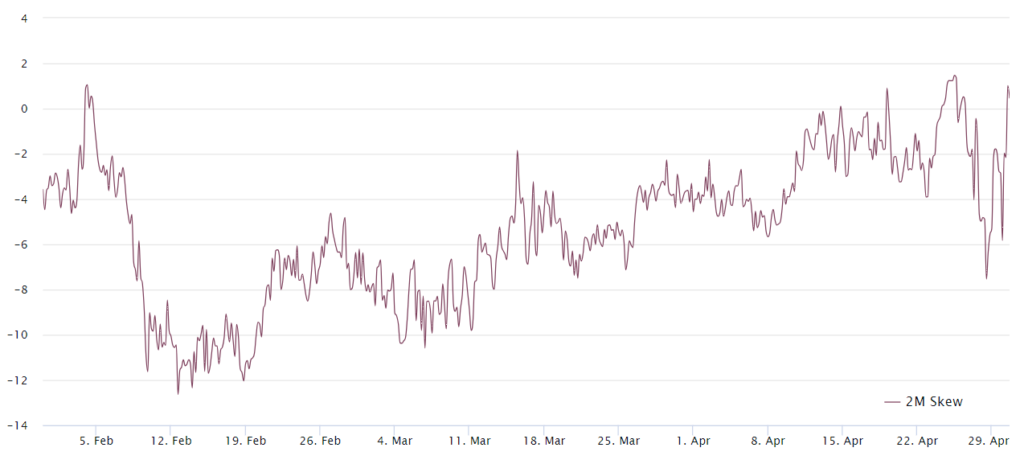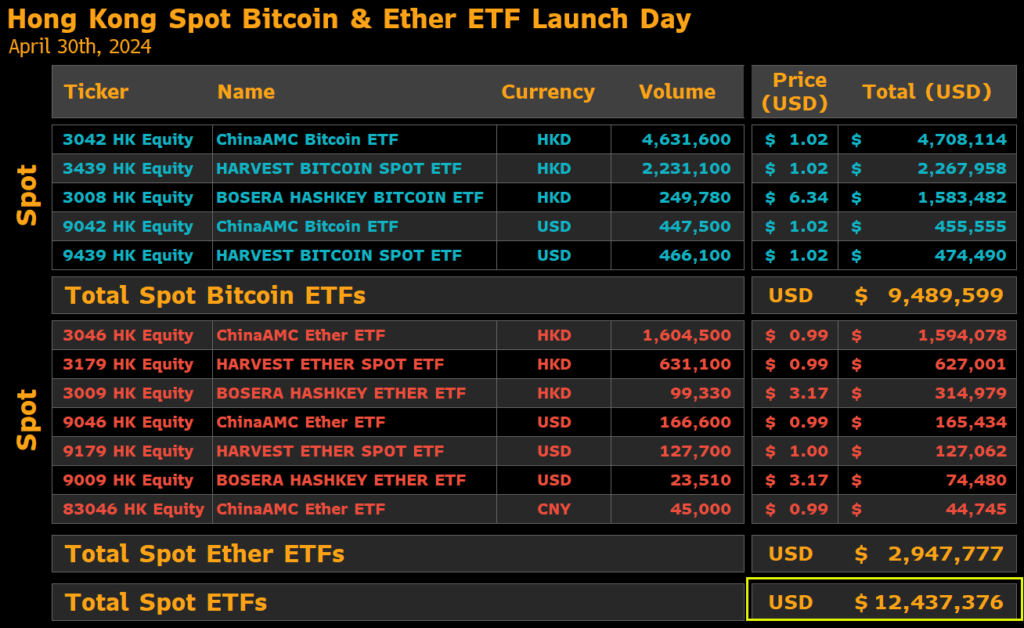
Bitcoin price revisits recent lows as the BTC futures premium falls to a 5-month low. Is the bull market over Bitcoin price fell sharply on April 30 following the unimpressive launch of a spot BTC exchange-traded fund (ETF) in Hong Kong. Despite expectations of $140 million in demand, the total trading volume, including Ether
ETFs, on the opening day was just $12.4 million. As a result, the premium on BTC futures dropped to its lowest level in five months, signaling a possible bearish outlook.
Negative pressure stems from weak macro conditions and U.S. spot BTC ETF flows

It is important not to rush to conclusions, as other factors have also weighed on Bitcoin’s price. These include diminished investor confidence in the ability of the United States Federal Reserve (Fed) to reduce interest rates twice in 2024. Fed Chair Jerome Powell is expected to deliver his post-meeting remarks on May 1, prompting cryptocurrency traders to exercise increased caution.
The fourth straight session of net outflows from U.S.-listed spot Bitcoin ETFs has raised concerns among traders. Investors have been withdrawing funds from the Grayscale GBTC ETF due to its high fees, while the Blackrock IBIT ETF has seen little activity. Therefore, despite the lackluster performance of the Hong Kong spot ETF, the appetite for such investments in the U.S. appears to be waning.
Previously, the Hong Kong exchange (HKEX) had listed cryptocurrency ETFs based on futures contracts, attracting $529 million in net inflows in the first quarter of 2024. Therefore, the weak debut of the spot instrument on April 30 was unexpectedly disappointing for many. However, some analysts, including Bloomberg’s Eric Balchunas, suggest that poor timing might have contributed to the low trading volumes.
The S&P 500 is set to record its first negative monthly performance in six months this April, and yields on U.S. 5-year Treasury notes increased from 4.2% to 4.7% over the month, reflecting higher return demands from investors. Traders often exit fixed-income positions if they fear rising inflation or expect continued growth in U.S. debt. As the government is compelled to increase market liquidity, the value of its bonds decreases.
Moreover, the recent drop in Bitcoin’s price to $60,172 on April 30 can be attributed to fears of an economic slowdown. McDonald’s reported a modest 2% year-over-year growth in adjusted earnings, and automaker Volkswagen announced a 2% drop in sales for the first quarter of 2024.
Bitcoin options markets show a different and milder perspective
Given the volatility in traditional markets and the decreased interest from institutional investors in Bitcoin ETFs, it is not surprising that the BTC futures premium reached its lowest level in five months. In stable market conditions, monthly contracts usually trade at a premium of 5% to 10% above spot markets, attributed to their longer settlement periods.

According to Laevitas.ch, the annualized premium for BTC futures fell to 7.5% on April 30, a drop from 11% just a week earlier. Despite the worsening sentiment, this indicator remained at a neutral level—a relatively positive sign considering that Bitcoin’s price had declined by 9.5% over the previous week.
Related: Why is Ethereum (ETH) price down today?
It’s also crucial to examine the BTC options skew to gauge market sentiment more accurately. Generally, a skew metric above 7% signals expectations of a price drop, whereas a skew below -7% indicates bullish sentiment.

The BTC options delta skew shifted from a bullish -7% on April 28 to a neutral 1% currently, suggesting a balanced demand for call (buy) and put (sell) options.
This shift indicates that investors were initially optimistic about the Hong Kong spot ETF launch but quickly adjusted their expectations after seeing the disappointing trading volumes. Consequently, traders should not be overly alarmed by the decline in the Bitcoin futures premium.
BTC price falls below $60K as Hong Kong ETF launches
Bitcoin fell to a weekly low of $60,543 on April 30, a day after the launch of the first batch of spot Bitcoin ETFs in Hong Kong. The world’s first cryptocurrency is down over 7.3% on the weekly and 13% on the monthly chart, according to CoinMarketCap.

The Hong Kong-based ETFs only amassed $12.4 million in trading volume during the first day, which pales compared to the first-day trading volume of U.S. spot Bitcoin ETFs, valued at $4.6 billion.
However, this is a high figure considering the size of the Hong Kong market, equivalent to $1.6 billion worth of trading volume in the United States, according to senior Bloomberg ETF analyst Eric Balchunas.
Balchunas wrote in an April 30 X post:
“You have to understand [that Hong Kong] is 1/168th the size of the U.S… That said, Hong Kong ETFs launched at a good time as the U.S. is slowing, so their $141m+ in inflows going to more than offset slightly negative U.S. flows.”

Approximately 14% of the $12.4 million daily trading volume was captured by spot Ether ETFs in Hong Kong with 86% flowing into Bitcoin-based ETFs.
Bitcoin ETF news “gets absorbed”
Bitcoin’s price drop after the debut of Hong Kong ETFs is a typical “sell-the-news” event, according to Mehdi Lebbar, the co-founder of institutional-grade risk assessment platform Exponential.
Over in the United States, weekly Bitcoin ETF net flows remain negative. The ten Bitcoin ETFs saw over $257 million worth of negative net outflows this week, down from over $396 million in negative outflows during the previous week, according to Dune data.
The U.S.-based ETFs were a significant part of Bitcoin’s price appreciation in 2024. By Feb. 15, Bitcoin ETFs accounted for about 75% of new investment in the world’s largest cryptocurrency as it surpassed the $50,000 mark, according to CryptoQuant research.
Related: Bitcoin outperforms Tesla stock for the first time since 2019
More downside ahead for Bitcoin?
Bitcoin was already on a downward trend over the previous weeks, which could see it fall below the $60,000 mark, according to Ben Caselin, the CMO of VALR exchange.
conclusion:
the recent negative pressure on Bitcoin’s price, influenced by weak macro conditions and U.S. spot BTC ETF flows, underscores the complexity of cryptocurrency market dynamics. While concerns over the Federal Reserve’s actions and disappointing ETF performances have weighed on sentiment, other factors such as rising Treasury yields and fears of an economic slowdown also contribute to the current market landscape. However, amidst these challenges, the Bitcoin options markets present a milder perspective, with indicators suggesting a balanced demand for options despite the recent decline in futures premium. Therefore, it’s essential for traders to consider the broader market context and refrain from hasty conclusions, recognizing the nuanced interplay of various factors shaping Bitcoin’s trajectory.
FAQS:
1. Why is Bitcoin experiencing negative pressure despite recent market developments?
- Bitcoin’s negative pressure is attributed to a combination of weak macroeconomic conditions and decreasing flows into U.S. spot BTC ETFs. Factors such as investor confidence in the Federal Reserve’s ability to reduce interest rates and the recent outflows from U.S.-listed spot Bitcoin ETFs contribute to this pressure.
2. What factors have contributed to the decline in U.S. spot Bitcoin ETF flows?
- The decline in U.S. spot Bitcoin ETF flows can be attributed to various factors, including investors withdrawing funds from high-fee ETFs like Grayscale GBTC and limited activity in ETFs like Blackrock IBIT. Additionally, the weak debut of the spot instrument on April 30 and concerns over rising interest rates may have impacted investor appetite for such investments.
3. How have market conditions influenced Bitcoin futures premium levels?
- Market conditions, including volatility in traditional markets and decreased institutional interest in Bitcoin ETFs, have contributed to the BTC futures premium reaching its lowest level in five months. Typically, monthly contracts trade at a premium above spot markets, but this premium has decreased amid current market uncertainties.
4. What insights do Bitcoin options skew metrics provide into market sentiment?
- Bitcoin options skew metrics provide valuable insights into market sentiment. A skew above 7% suggests expectations of a price drop, while a skew below -7% indicates bullish sentiment. The recent shift in Bitcoin options delta skew from bullish to neutral suggests a balanced demand for call and put options, reflecting adjusted expectations following the disappointing launch of the Hong Kong spot ETF.
5. How do recent macroeconomic indicators impact Bitcoin’s price movement?
- Recent macroeconomic indicators, such as the S&P 500 recording its first negative monthly performance in six months and increasing yields on U.S. 5-year Treasury notes, have contributed to fears of an economic slowdown. This, coupled with reports of modest earnings growth from companies like McDonald’s and a decline in sales for automaker Volkswagen, has influenced Bitcoin’s price movement, leading to increased caution among cryptocurrency traders.


